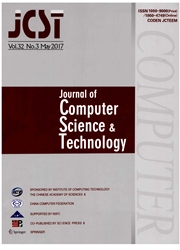

 中文摘要:
中文摘要:
3D 在真实环境当模特儿树是在计算机图形和计算机视觉的挑战,自从树的几何形状和拓扑构造比常规人工的目标更复杂。在这篇论文,我们在场主要在 2D 空间被执行忠实地构造箱子和 main 的 3D 的一条多过程途径从一幅单个区域图象一棵真实的树分叉。区域图象首先被分割进补丁由跳边缘检测基于深度断绝。粗糙的骨骼点和起始的半径然后从每个补丁的轮廓被计算。轴方向用装入每个粗糙的骨骼点的邻居的柱体被估计。在轴方向的帮助下,骨骼节点和相应半径被计算。最后,这些骨骼节点是连接的教主的联盟者,并且不适当的半径基于工厂知识被修改。从真实的树的单个区域图象产生的 3D 表明我们的方法的有效性。这篇论文的主要贡献基于轴方向是由单个扫描和骨骼计算的图象存储器顺序的优点的简单重建。电子增补材料这篇文章(doi:10.1007/s11390-007-9095-6 ) 的联机版本包含增补材料,它对授权用户可得到。
 英文摘要:
英文摘要:
3D modeling of trees in real environments is a challenge in computer graphics and computer vision, since the geometric shape and topological structure of trees are more complex than conventional artificial objects. In this paper, we present a multi-process approach that is mainly performed in 2D space to faithfully construct a 3D model of the trunk and main branches of a real tree from a single range image. The range image is first segmented into patches by jump edge detection based on depth discontinuity. Coarse skeleton points and initial radii are then computed from the contour of each patch. Axis directions are estimated using cylinder fitting in the neighborhood of each coarse skeleton point. With the help of axis directions, skeleton nodes and corresponding radii are computed. Finally, these skeleton nodes are hierarchically connected, and improper radii are modified based on plant knowledge. 3D models generated from single range images of real trees demonstrate the effectiveness of our method. The main contributions of this paper are simple reconstruction by virtue of image storage order of single scan and skeleton computation based on axis directions.
 同期刊论文项目
同期刊论文项目
 同项目期刊论文
同项目期刊论文
 期刊信息
期刊信息
